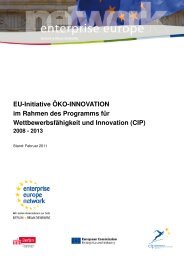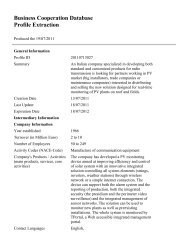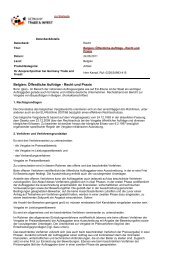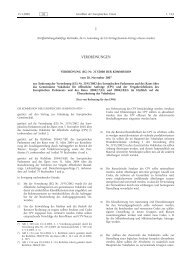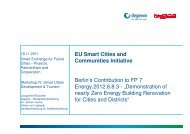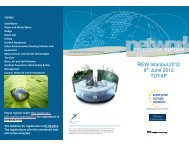Photonics Driving Economic Growth in Europe - Photonics21
Photonics Driving Economic Growth in Europe - Photonics21
Photonics Driving Economic Growth in Europe - Photonics21
You also want an ePaper? Increase the reach of your titles
YUMPU automatically turns print PDFs into web optimized ePapers that Google loves.
2. <strong>Photonics</strong> Research and Innovation Challenges<br />
EIR sources<br />
As a consequence of the low concentration of<br />
many critical analytes, there is a huge need of cost-<br />
effective, narrow-band, medium-power (1–100<br />
mW) light sources, allow<strong>in</strong>g the measurement<br />
process to be done quickly and with the required<br />
resolution. Of particular <strong>in</strong>terest are solid-state<br />
lasers, such as QCLs (Quantum Cascade Lasers),<br />
VECSELs (Vertical External Cavity Surface Emitt<strong>in</strong>g<br />
Lasers), VCSELs (Vertical Cavity Surface Emitt<strong>in</strong>g<br />
Lasers), and fibre lasers. S<strong>in</strong>ce many technologies<br />
utilise electronic lock-<strong>in</strong> methods, it must be possible<br />
to modulate the lasers electrically. For stable,<br />
efficient operation <strong>in</strong> the MIR/FIR, the lasers must<br />
be cooled and temperature-controlled, and care<br />
must be taken that these cool<strong>in</strong>g requirements<br />
do not dom<strong>in</strong>ate the production cost of the complete<br />
laser sub-system. For low-cost laser systems,<br />
electrical emission wavelength tun<strong>in</strong>g capability is<br />
desirable, with tun<strong>in</strong>g ranges of several 10 nm or<br />
up to a few 100 nm.<br />
A specific goal is the development of a family of tunable<br />
EIR light emitters. Complete laser system costs,<br />
<strong>in</strong>clud<strong>in</strong>g cool<strong>in</strong>g, modulation control, and electrical<br />
power supply, should reduce to a few €100.<br />
Additionally, NIR/MIR light-emitt<strong>in</strong>g diodes (LEDs)<br />
may be of <strong>in</strong>terest as an alternative source <strong>in</strong><br />
sens<strong>in</strong>g systems that do not require narrow-band<br />
illum<strong>in</strong>ation. New and more powerful sources for<br />
wide-band IR spectroscopy are also needed, such<br />
as those based on fibre supercont<strong>in</strong>uum effects,<br />
offer<strong>in</strong>g convenient coupl<strong>in</strong>g to optical fibres. Here<br />
the goal is the development of NIR/MIR broadband<br />
light sources offer<strong>in</strong>g emission powers ≥1 mW,<br />
with ≤ €1 cost <strong>in</strong> large volumes.<br />
EIR photodetectors (0D, 1D, 2D)<br />
A large number of materials and detector types<br />
are currently employed for po<strong>in</strong>t, l<strong>in</strong>ear and<br />
image sensor devices for the NIR/MIR spectral<br />
range, <strong>in</strong>clud<strong>in</strong>g pyroelectric detectors, thermo-<br />
piles, microbolometers, narrow-bandgap photo-<br />
voltaic detectors, Schottky barrier detectors, ex-<br />
tr<strong>in</strong>sic photoconductors, multi-quantum-well semi-<br />
conductor heterostructures for QCDs and homo/<br />
heterojunction <strong>in</strong>ternal photoemitters (HIP). The<br />
challenge is to detect as many <strong>in</strong>com<strong>in</strong>g photons as<br />
possible, while reduc<strong>in</strong>g the effects of dark current.<br />
This corresponds to the primary task of maximis-<br />
<strong>in</strong>g the sensor’s detectivity, which is equivalent<br />
to m<strong>in</strong>imis<strong>in</strong>g its noise equivalent power. At the<br />
same time, material and packag<strong>in</strong>g costs must be<br />
reduced to <strong>in</strong>creas<strong>in</strong>gly lower values, and cool<strong>in</strong>g<br />
requirements kept to a m<strong>in</strong>imum.<br />
The primary goal is to develop novel types of highly<br />
cost-effective solid-state NIR/MIR sensors, based<br />
on new or optimised material systems, and ideally<br />
produced us<strong>in</strong>g well-established microelectronic<br />
fabrication techniques. It must be straightforward<br />
to produce these sensors as po<strong>in</strong>t detectors, l<strong>in</strong>e<br />
sensors or image sensors, and they must have a<br />
performance close to the ideal detector limit. Po<strong>in</strong>t<br />
detectors should cost no more than €10, whilst<br />
l<strong>in</strong>e or image sensors should cost less than €100,<br />
<strong>in</strong>clud<strong>in</strong>g the cool<strong>in</strong>g devices.<br />
CMOS-based s<strong>in</strong>gle-photon NIR image sens<strong>in</strong>g<br />
It has been demonstrated recently that novel<br />
types of CMOS-based image sensors are capable<br />
of detect<strong>in</strong>g <strong>in</strong>dividual <strong>in</strong>cident photons at room<br />
temperature. Accept<strong>in</strong>g the need for cool<strong>in</strong>g, it<br />
should also be physically possible to extend the<br />
cut-off wavelength from silicon’s 1.1 µm to higher<br />
values <strong>in</strong> the NIR, while still be<strong>in</strong>g sensitive to each<br />
<strong>in</strong>cident photon. This requires scientific progress<br />
<strong>in</strong> two doma<strong>in</strong>s. Firstly, novel CMOS-based charge<br />
detection circuits with sub-electron readout noise<br />
performance are needed. Secondly, it will be necessary<br />
to comb<strong>in</strong>e these charge detector circuits with<br />
semiconduct<strong>in</strong>g materials exhibit<strong>in</strong>g a cut-off wavelength<br />
above silicon’s 1.1 µm. Promis<strong>in</strong>g candidates<br />
<strong>in</strong>clude nanostructured (black) silicon, <strong>in</strong>organic<br />
narrow-bandgap crystall<strong>in</strong>e semiconductors (such<br />
as InGaAs), or novel types of organic semiconductors<br />
sensitive <strong>in</strong> the NIR spectral doma<strong>in</strong>.<br />
63



